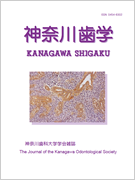- HOME
- > 一般の方
- > バックナンバー:神奈川歯学
- > 30巻2号
- > アブストラクト
アブストラクト(30巻2号:神奈川歯学)

Japanese
| Title : | 歯原性嚢胞の病理発生と歯の発育過程における歯原性上皮に生ずるapoptosisの相関についての免疫組織化学的検討 |
|---|---|
| Subtitle : | 原著 |
| Authors : | 秋山誠, 新藤潤一 |
| Authors(kana) : | |
| Organization : | 神奈川歯科大学口腔外科学教室第I講座 |
| Journal : | 神奈川歯学 |
| Volume : | 30 |
| Number : | 2 |
| Page : | 150-169 |
| Year/Month : | 1995 / 9 |
| Article : | 原著 |
| Publisher : | 神奈川歯科大学学会 |
| Abstract : | 「緒言」 Programed cell deathの一つと考えられるアポトーシス(apoptosis)は個体発生の過程で不必要となった細胞に生じる必然的な細胞死として生物学的領域で知られている. 現在, apoptosisは個体発生における正常な形態形成に関与するばかりでなく, 成熟個体においても種々の臓器における細胞の交代など基本的な生命現象に重要な生理的役割を果していると考えられている. 最近では, 胸腺細胞のnegative selectionすなわちトレランスを誘導する機構にapoptosisが関与していることが明らかにされ, さらに放射線や一部の抗癌剤による悪性腫瘍の細胞死, あるいはHIV感染リンパ球にapoptosisが発現することが示され, 病理学的にも極めて重要な課題として注目を集めている. そこで本研究では, 歯の形成に関与した歯堤上皮やエナメル上皮, Hertwing上皮鞘の生理的消失にapoptosisが関与するすること, さらに種々のヒト歯原性嚢細胞の原因となる歯原性上皮成分の顎骨内残存がapoptosisの発現異常によるものとの仮説に基づき, ヒト胎児エナメル器, Malassezの上皮遺残およびヒト上皮性歯根肉芽腫, 歯根嚢胞, 歯原性角化嚢胞についてapoptosis関連抗原であるLey抗原の発現とnick end labeling法によるDNA fragmentationの証明をapoptosisの指標として組織学的, 免疫組織化学的検索を行った. |
| Practice : | 歯科学 |
| Keywords : | 歯原性嚢胞, apoptosis, Ley抗原, 免疫組織化学 |
English
| Title : | Immunohistochemical Study on a Correlation Between Apoptosis of Odontogenic Epithelium During the Teeth Development and Odontogenic Cyst Formation |
|---|---|
| Subtitle : | Original article |
| Authors : | Makoto AKIYAMA, Junichi Sindoh |
| Authors(kana) : | |
| Organization : | The First Department of Oral and Maxillofacial Surgery, Kanagawa Dental College |
| Journal : | Kanagawa Shigaku |
| Volume : | 30 |
| Number : | 2 |
| Page : | 150-169 |
| Year/Month : | 1995 / 9 |
| Article : | Original article |
| Publisher : | Kanagawa Odontological Society |
| Abstract : | Abstract : In the domein of oral and maxillofacial surgery, any cystic lesion that occurs within the mandible is one of the major disease entities and epithelial element that causes the cyst is associated with epithelial remnants of the dental lamina in the mandible and Malassez's epithelial rests. Therefore, Malassez's epithelial rests in periodontium of extracted teeth, epithelial cells in the radicular granuloma, and lining epithelium of the radicular cyst and odontogenic keratocyst, immunohistchemically, expression of BM-1/JIMRO (Ley antigen) and using the nick end labeling method developed by Gavrieli et al. At the begining of the subject, morphologically examined a relation between DNA fragmentation associated with apoptosis and Ley antigen expression KB cells being oral suquamus cell carcinoma strain cells of human. For induced the apoptosis, KB cells after incubation 6 hours adding 0.1/ml of Vinblastine, a marked blebbing routed apoptosis observed to many KB cells and BM-1/JIMRO positive finding in the cells with blebs or nuclear fragmentation, and also positive findings in the pyknotic nucleus were observed DNA fragmentation by the uptake of trypan blue that these cells which have fragmentation and pyknosis of the nucleus were almost dead. This result was considered that Ley antigen and DNA fragmentation would be related to apoptosis of KB cells due to Vinblastine. Upon examination of the tooth germs for primary in the lower jaw of the fetus 20-22 weeks, the expression of BM/JIMRO (Ley antigen) was not ovserved at all in the enamel organ that appered to be in nomal shape. However, Ley expression inself in the external enamel epitheliums that irregularly protruded and also in part of the epitheliums of the dental lamima. Inpart of the epithelial cells, nick end labeling positive cells were observed, suggesting that there is a possibility of DNA fragmentation occurring in these cells. Whereas in Malassez's epithelial rests, there was no expression of Ley antigen. All these hindings suggested that the useless elements of the epitheliums of dental lamina and the overgrowths of external epitheliums may disappear due to apoptosis. The expression of Ley antingen in a radicular granuloma, Ley antigen is not evidence in the epithelial cells of reticular shape. But the expression of Ley antigen is remarkable in both intermediate and superficial cells of the lining epithelium, which looks like stratified squamous epithelium morphologically, in the radicular cyst. Whereas, in the odontogenic keratocyst, the cause of associated with the remnants of dental lamina and Malassez's epithelial rests, odontogenic epithelium felt over in the fibrous connective tissue of cyst walls neither Ley antigen nor nick end labeling positive cells found. For the above-mentioned results, it was suggested that the remaining odontogenic epitheliums causing cyst formation do not meet the physilogical cell death. |
| Practice : | Dentistry |
| Keywords : | apoptosis |
